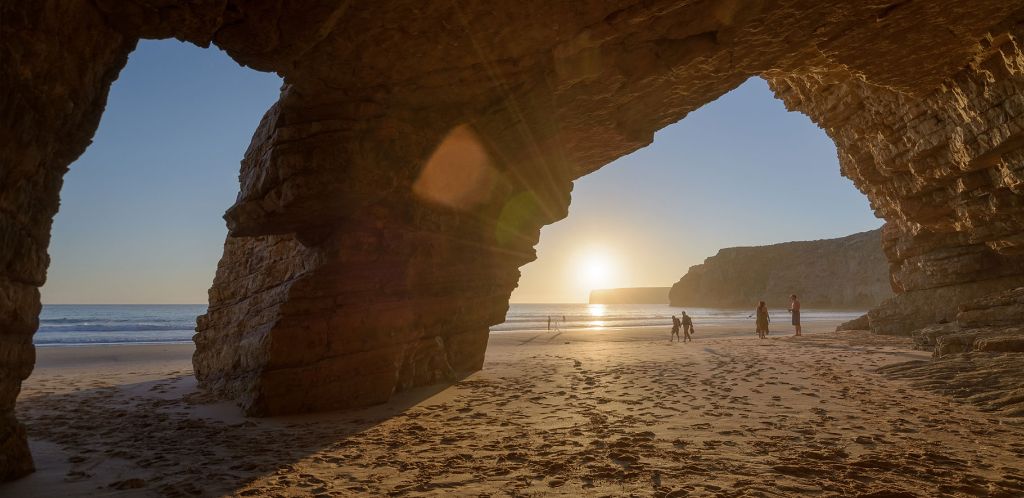Where the land ends and the ocean begins
In ancient times, Sagres was known as Promontorium Sacrum, a mythical place where the known world ended. Spirituality always left a mark on this land, as various religious rituals took place here. The more ancient ones were probably dedicated to Saturn, Heracles and Cronus; later, they summoned the Christian martyr, Saint Vicent.
Sagres is a village in the municipality of Vila do Bispo. It is a symbol of Portugal in the world as it inspired Prince Henry — and he used it as a spearhead — to begin the Portuguese Discoveries maritime odyssey in the 15th century.
Fishing traditions are also ancient. Likewise the rest of the Western Algarve, several tuna traps operated here; they were defended against Moorish pirates attacks by the fortresses of Baleeira and Beliche. Another important activity in this region was whaling. Sagres is part of the Natural Park of Sudoeste Alentejano e Costa Vicentina (Southwestern Alentejo and the Vicentina Coast) since the 80’s of the last century. Due to its unique natural values, it holds the only marine protected area of the south coast of the Algarve. This natural reserve includes the islets of Martinhal and the large sea stacks of Gigante and Gaivota.
Nowadays, in Sagres harbour (Baleeira) there are 65 registered vessels, representing 104 fishermen. Local Docapesca is one of the most eggerly sought wholesale fish markets due to the outstanding quality of its fish.
The main gears used are: trammel nets (cuttlefish and several sole species), bottom-set gill nets (axillary seabream, red mullet and common two-banded seabream), seine nets (pelagic species as sardines, horse-mackerel and mackerel) and long lines (breams, conger eel, stakes and forkbeard).
Some particular species require some special fishing gear. This is the case of monkfish: it is caught with gill nets (with only one wall) with meshes larger than 100 mm and deployed between 100–240 m deep. For lobsters, fishermen use pots and nets; after being caught and until the fish market auction, they are kept alive in running water. Sagres is a top selling wholesale fish market for lobster; notwithstanding, local fishermen voluntarily observe a closed season during the months of October to December. The large landed breams are captured by long lines baited with live crab (pilado), or sardines if this bait is unavailable.
Sagres fishing community is united and it is represented by its association. The group promotes fish processing innovative projects, aiming to increase the value of their products. Some of these projects are the wrapping of landed sardines in small chilled Styrofoam boxes, ready to be sold. In the future, they aim to improve the operational logistics on the fishing harbour and to certify the fishing products of Sagres. Some chefs even say, and not by casualty, that this is the best fish in the world.
Gastronomy
Within the fishing community, typical Sagres dishes are stuffed squids (prepared all over the year until Christmas), grilled bream, caldeirada (with common two-banded seabream, bream, skate and torpedo ray, dogfish, sardines), limpets stew and lobster rice. On the table, some snacks are mandatory: fried moray eel, whelk salad and, of course, from the Vincentina Coast, the famous barnacles, which are served while warm.
Festivities
Fishermen are known as men of faith. Processions in honour of our Nossa Senhora da Graça (Our Lady of Grace) begin on land and extend into the sea; the blessed vessels return to the harbour of refuge, on the 15th of August. Celebrations are also part of local costumes. On the last Sunday of May, it takes place the Fishermen’s Day, promoting conviviality within the community.
Must-Visit
Sagres Fortress, Beliche Fortress, Baleeira Fortress, São Vicente Cape, São Vicente Lighthouse, Baleeira harbour, Torre D’Aspa, Megalithic structures on Monte dos Amantes, Praia da Mareta, Praia do Martinhal, Praia do Castelejo, Praia do Telheiro, Praia da Murração, Ponta Ruiva,scuba-diving at Gruta do Martinhal, surf and bodyboard, wildlife watching – birds and marine mammals, sport fishing, water sports.


